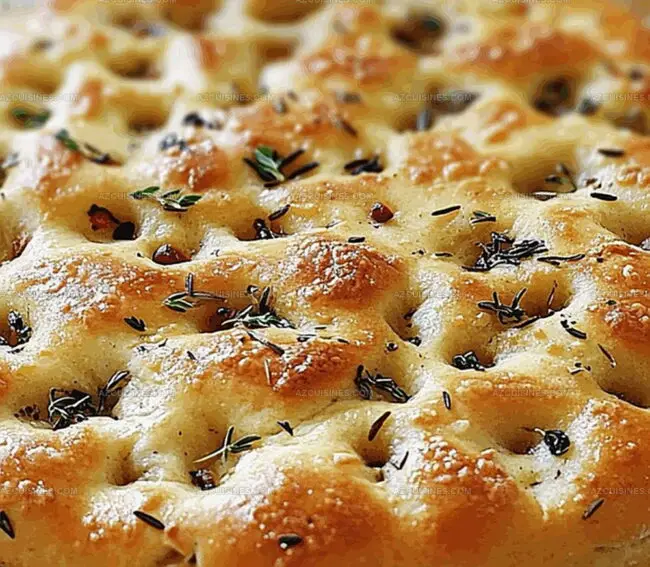Fluffy Golden Homemade Focaccia Recipe: A Bread Lover’s Dream
Crafting a delectable homemade focaccia brings pure culinary joy to passionate home bakers.
Mediterranean traditions inspire this simple yet remarkable bread that fills kitchens with incredible aromas.
Soft, pillowy textures and crisp edges make each slice irresistible.
Salt-sprinkled surfaces and herb-infused dough create magical moments of comfort and connection.
Italian bakers understand the art of transforming basic ingredients into extraordinary experiences.
Olive oil and fresh rosemary dance together, promising a sensational journey for anyone willing to knead and wait.
You’ll fall in love with every golden, fragrant bite that emerges from your oven.
Why Homemade Focaccia Feels Like Bakery Bliss
What You’ll Need To Make Focaccia
Bread Base:Yeast and Liquid:Flavor Enhancers:Herb and Seasoning Blend:Finishing Touches:How To Bake Focaccia From Scratch
Step 1: Awaken the Yeast
Mix yeast with warm water and let it bubble and transform into a frothy mixture. Watch as the tiny organisms come to life and create a soft, foamy texture.
Step 2: Build the Flour Foundation
In a spacious mixing bowl, combine:Create a gentle crater in the center to welcome the yeast mixture.
Step 3: Merge Wet and Dry Ingredients
Pour the activated yeast into the flour crater. Add olive oil and blend until a rough, shaggy dough emerges. The mixture will look uneven and slightly messy.
Step 4: Develop Dough Strength
Transfer the dough to a floured work surface. Knead vigorously for 8-10 minutes. Press, fold, and stretch the dough until it becomes smooth, silky, and elastic.
Step 5: First Dough Rise
Place the dough in a lightly oiled bowl. Cover with a damp cloth and let it rest in a warm, cozy spot. Allow the dough to expand and double in size, which takes about an hour.
Step 6: Shape the Focaccia
Gently deflate the risen dough. Move it to a generously oiled baking sheet. Stretch and spread the dough to cover the entire surface, creating a rustic, uneven landscape.
Step 7: Create Signature Dimples
Use your fingertips to press small indentations across the dough surface. These characteristic wells will capture flavor and create a classic focaccia texture.
Step 8: Add Herbal Touches
Sprinkle dried rosemary and oregano evenly across the dough. The herbs will infuse the bread with aromatic Mediterranean flavors.
Step 9: Second Dough Rise
Let the dough rest and proof for 30 minutes at room temperature. The bread will become puffy and light.
Step 10: Prepare the Oven
Heat the oven to 425°F. The high temperature will create a crispy exterior and soft interior.
Step 11: Final Flavor Enhancements
Drizzle extra virgin olive oil over the dough. Scatter:Step 12: Add Finishing Salt
Sprinkle coarse sea salt across the top. This will provide a delightful crunch and enhance the overall flavor profile.
Step 13: Bake to Golden Perfection
Slide the baking sheet into the oven. Bake for 20-25 minutes until the focaccia turns a beautiful golden brown with crispy, slightly darker edges.
Step 14: Cool and Serve
Remove from the oven and transfer to a wire rack. Allow the bread to cool for 10 minutes. Slice and serve warm, enjoying the herbs, salt, and olive oil’s incredible aroma.
Focaccia Tips For Great Results
Creative Takes On Homemade Focaccia
What Goes Well With Homemade Focaccia
Smart Storage Tips For Homemade Focaccia
FAQs On Baking Homemade Focaccia
Activating yeast helps ensure proper fermentation and creates a light, airy texture in the focaccia by allowing the yeast to become frothy and alive before mixing with other ingredients.
A well-kneaded dough will feel smooth, elastic, and spring back when gently pressed. After 8-10 minutes of kneading, the dough should no longer be sticky and will have a consistent, stretchy texture.
The dimples are a signature focaccia technique that helps create pockets for olive oil to collect, resulting in a crispy surface and preventing the bread from rising too much during baking.
Print
Homemade Focaccia Recipe
- Total Time: 1 hour 35-40 minutes
- Yield: 8 1x
Description
Rustic Italian Focaccia brings Mediterranean warmth to kitchen counters with its golden, herb-infused crust. Simple ingredients and gentle kneading create a bread that connects generations through delicious, aromatic comfort you’ll savor slice by slice.
Ingredients
Main Ingredients:
- 4 cups bread flour
- 2 tsp active dry yeast
- 1.5 cups warm water
- 4 tbsp olive oil
Herbs and Seasonings:
- 2 tsp sea salt
- 1 tbsp dried rosemary
- 1 tbsp dried oregano
Toppings:
- 2 tbsp extra virgin olive oil
- 1 tsp coarse sea salt
- 2 cloves garlic, minced
- 1/4 cup chopped fresh basil leaves
Instructions
- Activate the yeast by dissolving it in warm water, allowing it to foam and become frothy for about 5-7 minutes.
- In a large mixing bowl, combine bread flour and sea salt, creating a well in the center for the yeast mixture.
- Pour the activated yeast into the flour, incorporating olive oil and mixing until a shaggy dough forms.
- Knead the dough on a floured surface for 8-10 minutes until smooth and elastic, developing gluten structure.
- Transfer the dough to a lightly oiled bowl, cover with a damp cloth, and let rise in a warm spot for approximately 1 hour or until doubled in size.
- Punch down the risen dough and transfer to a generously oiled baking sheet, gently stretching it to cover the entire surface.
- Dimple the dough surface using fingertips, creating characteristic focaccia texture.
- Sprinkle dried rosemary and oregano across the dough, ensuring even distribution.
- Let the dough rest and proof for an additional 30 minutes at room temperature.
- Preheat the oven to 425°F (218°C) while the dough is proofing.
- Before baking, drizzle extra virgin olive oil over the surface and scatter minced garlic and fresh basil leaves.
- Sprinkle coarse sea salt across the top for enhanced flavor and texture.
- Bake for 20-25 minutes until golden brown and crispy around the edges.
- Remove from oven and let cool on a wire rack for 10 minutes before slicing and serving.
Notes
- Choose high-protein bread flour for optimal gluten development, ensuring a chewy and airy texture.
- Maintain warm water temperature between 100-110°F when activating yeast to prevent killing the live cultures.
- Allow sufficient proofing time for maximum flavor complexity and authentic Italian-style bread structure.
- Experiment with alternative toppings like sundried tomatoes, olives, or caramelized onions for unique flavor variations.
- Prep Time: 1 hour 15 minutes
- Cook Time: 20-25 minutes
- Category: Snacks, Appetizer, Lunch, Dinner
- Method: Baking
- Cuisine: Italian
Nutrition
- Serving Size: 8
- Calories: 220
- Sugar: 0.5 g
- Sodium: 400 mg
- Fat: 7 g
- Saturated Fat: 1 g
- Unsaturated Fat: 6 g
- Trans Fat: 0 g
- Carbohydrates: 34 g
- Fiber: 1 g
- Protein: 6 g
- Cholesterol: 0 mg




Truc Tran (Kris)
Senior Food Editor
Expertise
Home Cooking, Meal Planning, Recipe Development, Baking and Pastry, Food Editor, Cooking-video Maker, Vietnamese Food Evaluation Expert
Education
Truc Tran (Kris), an experienced food writer and editor, is great at exploring and describing global cuisines, from simple street food to fancy dining. In her writing, she skillfully mixes different flavors, cooking methods, and culinary traditions, showing the unique character of various cultures through their food and drinks. On azcuisines.com, Kris highlights her knowledge, especially in Asian cuisine and worldwide traditional dishes.